


Staffing Smarts
Labor scheduling is consistently among a retailer’s daily operational headaches. Schedule too much staff and you’re needlessly assuming extra costs with little to no return or reward. Schedule too few and you may end up with unhappy customers and potentially lost sales due long checkout lines and spotty customer service.
That’s why consumer behavior analytics, including data from traffic counters, can help retailers make data-driven decisions about their staffing needs. Is Monday night your slowest time of the week? Then there’s no need to have six workers on hand when two will suffice. With clear insights into the ebb and flow of customer traffic, you can right-size your staffing needs to align your costs with customer demand.
When Shoppers Are Shopping
Indeed, staffing needs are directly correlated to how much customer demand your store typically gets on any given day, week or month, with holiday seasons typically calling for “all hands on deck.” Without a clear picture of when shoppers are visiting your store, your in-store operations are just a shot in the dark.
Armed with valuable footfall insights from traffic counters and consumer behavior analytics, you can develop strategies to increase traffic. Perhaps it’s a shopping “happy hour” every Wednesday evening, as plus-size fashion retailer Eloquii just launched in its inaugural Washington, D.C.-area store. Shoppers are invited in for a special in-store-only two-hour promotion, accompanied by treats and libations.
The bottom line: consumer behavior analytics can help you identify problem areas but it’s up to you to be creative with the in-store solutions.
Where Shoppers Are Going
Many of the metrics related to consumer behavior analytics in recent years focus on tracking the shopper journey through store. Sensors and sophisticated traffic-counting systems can reveal where the shopper begins and ends her journey, where she dwells — and where she doesn’t.
With details on customer dwell patterns, retailers can get a sense of where their in-store “hotspots” are and merchandise those areas accordingly. Are shoppers flocking to winter coats? Position hats, gloves and other winter accessories in that area, too. Are shoppers ignoring the merchandising display you painstakingly created? Shift it to where your traffic counters tell you that shoppers are naturally going.
If you’re noticing that some aisles are almost always vacant, take a look at that space and see what your customers are seeing. It could be that the selection of merchandise is unappealing or perhaps that aisle tends to be cluttered and messy. Whatever the case, consumer behavior analytics can help you turn around an underperforming area of your store.
How Much Maintenance Is Enough?
Store maintenance costs partially boil down to how much footfall your facility sees. A deep clean and tune-up once monthly in February and March might suffice but you’ll likely need greater attention to detail to keep your store tidy and in presentable shape for the overwhelming holiday crowds. With data and analytics from people counters, you can better determine what your maintenance budget should be.
It’s Raining, It’s Pouring
Look to your people counters to identify trends in how weather affects footfall, which in turn informs your in-store operations. If you know that tomorrow will bring a nor’-easter, it might be wise to reduce the number of staff who are scheduled to work, and to position your weather-related merchandise near the front entrance. And if you notice that store traffic dips during bad weather, it might be wise to encourage your customers to shop on your website instead.
More than ever, retailers must turn to consumer behavior analytics to elevate their in-store operations. With competition in retail increasing, retailers leveraging data-driven insights are poised to win greater loyalty — and profits.